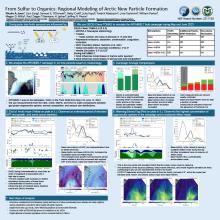From Sulfur to Organics: Regional Modeling of Arctic New Particle Formation
Nicole
June
Colorado State University
Poster
New particle formation (NPF) and growth events are important contributors to cloud condensation nuclei (CCN). CCN are important to understand due to their impacts on planetary radiative forcing. The Arctic is a region of interest due to it experiencing warming at a faster rate than the mid-latitudes. We use data collected on board an icebreaker during the Spring 2023 ARTofMELT field campaign. We use the GEOS-Chem-TOMAS model to simulate the aerosol size distributions, particulate matter composition, and gas-phase sulfur chemistry. We conduct several sensitivity simulations in order to understand the processes contributing to the observed size distributions and to yield better model-observation agreement. We use an expansion of marine sulfur chemistry to better represent the contribution of dimethyl sulfide (DMS) to NPF and CCN. Our base case simulations suggest a low-bias for organic aerosol during the campaign, particularly during periods of open-ocean influence, leading us to add an additional arctic marine source of secondary organic aerosol precursor. This additional source improves the agreement with the observed organic aerosol concentration. Both the base case simulation and simulation with additional arctic marine SOA underestimate NPF and growth. We add an nucleation mechanism involving organics with sulfuric acid to the model, which yields better agreement with the observations in the Aitken mode. We also add a size-dependent mass accommodation coefficient to favor the condensation to smaller particles in an attempt to increase the growth of the particles. The base case and all sensitivity simulations have periods of overprediction in the accumulation mode sized particles, potentially due to biases in wet removal. For the final sensitivity simulation, we make updates to the wet removal scheme. For all simulations we examine the impact on model-observation agreement during the campaign, CCN concentration, and the aerosol indirect radiative effect.

June-Nicole-Poster.pdf
(2.32 MB)
Meeting homepage
